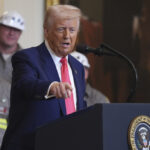The Impact of Trump’s Executive Order on Reciprocal Tariff Negotiations

President Trump introduced reciprocal tariffs on Apr. 2, urging foreign countries not to retaliate or face even higher tariffs from the U.S., as Treasury Secretary Scott Bessent warned. Despite not retaliating, foreign countries still risk facing Trump’s tariffs due to the order’s focus on trade deficits instead of trade policies. This poses a challenge present in distinguishing between retaliatory actions and trade policies’ impacts.
Foreign countries risk facing higher reciprocal tariffs, even if they lessen their protectionist measures, highlighting the disconnect between the executive order and foreign protectionism. Trump’s approach to calculating tariffs solely based on trade surpluses doesn’t reflect other countries’ tariff policies or non-tariff barriers, posing difficulties in effective negotiation.
Trade deficits stem from various factors beyond trade policies, such as demographics, productivity growth, and fiscal and monetary policies, complicating the effectiveness of Trump’s tariffs in addressing bilateral trade balances. Notably, attacking bilateral trade deficits may not address the larger investment-savings gap, potentially increasing deficits with other countries.
Trump’s push for reciprocal tariffs to boost U.S. manufacturing showed mixed results, with selected industries benefiting at the expense of downstream users. Foreign retaliation risks undermining U.S. export industries, raising concerns about the future consequences of the escalating trade tensions.
The executive order’s guidelines for modifying reciprocal tariffs based on deficits, retaliation, trade practices, and manufacturing capacity represent an unclear strategy linked to protectionism. Trump’s approach lacks coherence between tariffs and intended outcomes, potentially hindering effective negotiation tactics.
To ensure successful negotiations, Trump should focus on pursuing fair and reciprocal trade policies rather than aiming for a complete elimination of bilateral trade imbalances. This approach could provide a more structured and credible basis for international trade discussions.






















































































































































































































































































































































































































































































































































































































































































































































































































































































































































































































































































































































































































































































































































































































































































































































































































































































































































































































































































































































































































































































































































































































































































































































































































































































































































































































































































































































